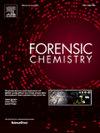Extraction approaches for A-230, A-234, VX, and sarin nerve agents from surface coatings
IF 2.6
3区 医学
Q2 CHEMISTRY, ANALYTICAL
引用次数: 0
Abstract
Nerve agents are among the most hazardous chemical warfare agents (CWAs) due to their extreme toxicity. This study optimized methods for extracting CWAs (A-230, A-234, VX, and sarin) from surface coatings, a common but chemically complex matrix in urban environments. Four types of coatings (nitrocellulose, polyurethane, acrylic, and alkyd) were tested using bulk, wipe, and scrape extraction approaches with various solvents. Versatile methods were successfully developed for all four analytes across all four matrices, and recoveries were also determined for additional CWAs (soman, cyclosarin, and sulfur mustard). Bulk extraction consistently achieved the highest recoveries, while wipe extraction offered a practical alternative with slightly reduced efficiency. Scrape extraction exhibited high variability and was unsuitable for volatile compounds like sarin. The methods were evaluated using gas chromatography with flame ionization detection, demonstrating robust analytical performance, including high sensitivity, precision, minimized matrix effects, and validated accuracy through spiking recoveries. Persistence studies revealed slow dissipation rates in surface coatings, underscoring their forensic potential when other matrices yield only degradation products. A-230 and A-234 were detectable in all coatings for up to 56 days, whereas sarin dissipated rapidly, especially in acrylic paint. VX remained primarily in surface layers due to its high viscosity and limited diffusion. These findings highlight the importance of tailoring extraction methods to specific matrices and agents. Coatings, with their prolonged retention of CWAs, not only provide significant forensic value but also emphasize the need for targeted decontamination strategies to mitigate environmental and human health risks.

从表面涂层中提取A-230, A-234, VX和沙林神经毒剂的方法
神经毒剂由于其极高的毒性,是最危险的化学战剂之一。本研究优化了从城市环境中常见但化学复杂的表面涂层中提取CWAs (a -230, a -234, VX和沙林)的方法。四种类型的涂料(硝基纤维素、聚氨酯、丙烯酸和醇酸)采用不同溶剂的散装、擦拭和刮提方法进行了测试。成功开发了针对所有四种基质的所有四种分析物的通用方法,并确定了其他CWAs(索曼、环沙林和硫芥)的回收率。大量提取始终获得最高的回收率,而擦拭提取提供了一种实用的替代方案,但效率略有降低。刮刮提取具有较高的变异性,不适合沙林等挥发性化合物。采用气相色谱法和火焰电离检测对这些方法进行了评估,结果表明,这些方法的分析性能稳定,包括高灵敏度、精密度、最小基质效应以及通过峰值回收率验证的准确性。持久性研究揭示了表面涂层的缓慢耗散速率,强调了它们在其他基质只产生降解产物时的法医潜力。A-230和A-234在所有涂料中可检测到长达56天,而沙林消散迅速,特别是在丙烯酸涂料中。由于VX的高粘度和有限的扩散,它主要停留在表层。这些发现强调了针对特定基质和试剂定制提取方法的重要性。涂料可以长期保留碳水化合物,不仅具有重要的法医价值,而且还强调需要有针对性的去污战略,以减轻环境和人类健康风险。
本文章由计算机程序翻译,如有差异,请以英文原文为准。
求助全文
约1分钟内获得全文
求助全文
来源期刊

Forensic Chemistry
CHEMISTRY, ANALYTICAL-
CiteScore
5.70
自引率
14.80%
发文量
65
审稿时长
46 days
期刊介绍:
Forensic Chemistry publishes high quality manuscripts focusing on the theory, research and application of any chemical science to forensic analysis. The scope of the journal includes fundamental advancements that result in a better understanding of the evidentiary significance derived from the physical and chemical analysis of materials. The scope of Forensic Chemistry will also include the application and or development of any molecular and atomic spectrochemical technique, electrochemical techniques, sensors, surface characterization techniques, mass spectrometry, nuclear magnetic resonance, chemometrics and statistics, and separation sciences (e.g. chromatography) that provide insight into the forensic analysis of materials. Evidential topics of interest to the journal include, but are not limited to, fingerprint analysis, drug analysis, ignitable liquid residue analysis, explosives detection and analysis, the characterization and comparison of trace evidence (glass, fibers, paints and polymers, tapes, soils and other materials), ink and paper analysis, gunshot residue analysis, synthetic pathways for drugs, toxicology and the analysis and chemistry associated with the components of fingermarks. The journal is particularly interested in receiving manuscripts that report advances in the forensic interpretation of chemical evidence. Technology Readiness Level: When submitting an article to Forensic Chemistry, all authors will be asked to self-assign a Technology Readiness Level (TRL) to their article. The purpose of the TRL system is to help readers understand the level of maturity of an idea or method, to help track the evolution of readiness of a given technique or method, and to help filter published articles by the expected ease of implementation in an operation setting within a crime lab.
 求助内容:
求助内容: 应助结果提醒方式:
应助结果提醒方式:


